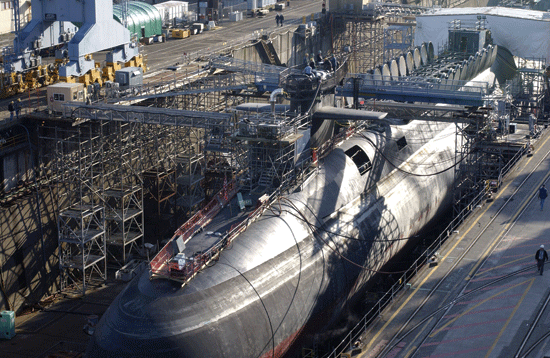Electric Boat Bets on Sub Budget Boost
Posted on

The USS Ohio being converted from a nuclear missile submarine (SSBN) to a conventional missile one (SSGN). By 2028, all four SSGNs will have retired.
[UPDATED with total hiring figures] WASHINGTON: Navy demand for submarines is so strong that sub-builder Electric Boat is betting on growth, despite the bleak budget outlook for defense in general. Connecticut congressman Joe Courtney, the top Democrat on the House seapower subcommittee, exulted in a statement this morning that his home state yard expects to add 900 jobs — 840 of them in Connecticut — in 2016. That’s a significant gain — just over six percent — for a yard whose current workforce is 14,100.
EB expects total hiring in Connecticut to be about 1,500 new employees, but anticipated attrition means the net growth is much smaller. Total hiring at the company’s Rhode Island facilities will be 300.
Overall, Courtney’s statement said, “investment in key submarine programs like the Virginia Class Submarine, Virginia Payload Module and the Ohio replacement program is expected to increase 11% in 2017 — to about $8 billion — compared to the $7.2 billion allocated in 2016.”
As we’ve written before, the Navy plans to grow those three programs so fast that — if the money materializes — they might create a production bottleneck at Electric Boat and the nation’s only manufacturer of nuclear submarines, Newport News in Virginia. (Electric Boat belongs to General Dynamics, Newport News belongs to Huntington Ingalls). Yet they’re such a high priority that Defense Secretary Ashton Carter wants to cut the Navy’s Littoral Combat Ship program to, among other things, invest in subs.

The Virginia-class attack submarine USS Minnesota under construction in Newport News.
Submariners’ Big Three: Virginia, VPM, & ORP
What are the three programs and why do they matter?
The Virginia class is the nation’s cutting edge nuclear-powered attack sub (SSN), capable of attacking ships with torpedoes and land targets with Tomahawk missiles. Unlike Russia and China, however, the US lacks a sub-launched anti-ship missile — and Russia and China are growing their fleets in both sophistication and numbers, while the US fleet is shrinking as Los Angeles boats retire faster than new Virginias enter service. Still, the Virginia program has been praised for steadily improving on both cost and schedule, and Congress is funding two Virginia subs per year. Carter’s cut to LCS would pay for upgrades to a dozen Virginias.
The Virginia Payload Module is a modification to the Virginia that lengthens the hull to accommodate more missile launchers, enough for 28 additional Tomahawks, which triples the current payload of 12. The Navy urgently wants VPM because most of its sub-launched missile launchers are going away as the four SSGN submarines age out of service, taking 616 missile tubes with them. Replacing that firepower at the currently planned rate of one VPM sub a year will take 22 years. Carter’s LCS cut would pay for an additional VPM.
The Ohio Replacement Program is a new ballistic missile submarine (SSBN) to replace the aging Ohio class. Subs are the most survivable leg of the nuclear triad, able to hide in ways that bombers and missile silos never could. But at roughly twice the size of a Virginia and an estimated , each ORP sub is a huge investment, estimated at $6 to 8 billion. The whole 12-sub program costs $79 to $92 billion — depending on whose estimate you believe — and could bust the shipbuilding budge. That’s why Rep. Courtney and HASC Seapower chairman Rep. Randy Forbes created a National Sea-Based Deterrent Fund to pay for the subs outside the Navy budget, a controversial move.
Correction: An earlier version of this article said Electric Boat’s workforce was only 3,700; in fact that’s the workforce in Rhode Island alone. The current version of the story gives the accurate figure for EB’s total workforce, 14,100.
Subscribe to our newsletter
Promotions, new products and sales. Directly to your inbox.
